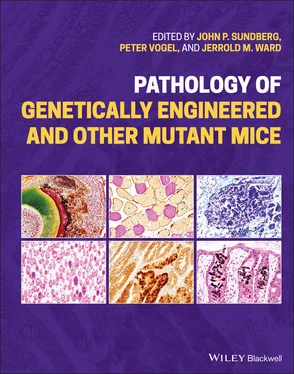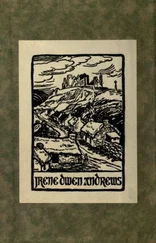Pathology of Genetically Engineered and Other Mutant Mice
Здесь есть возможность читать онлайн «Pathology of Genetically Engineered and Other Mutant Mice» — ознакомительный отрывок электронной книги совершенно бесплатно, а после прочтения отрывка купить полную версию. В некоторых случаях можно слушать аудио, скачать через торрент в формате fb2 и присутствует краткое содержание. Жанр: unrecognised, на английском языке. Описание произведения, (предисловие) а так же отзывы посетителей доступны на портале библиотеки ЛибКат.
- Название:Pathology of Genetically Engineered and Other Mutant Mice
- Автор:
- Жанр:
- Год:неизвестен
- ISBN:нет данных
- Рейтинг книги:3 / 5. Голосов: 1
-
Избранное:Добавить в избранное
- Отзывы:
-
Ваша оценка:
- 60
- 1
- 2
- 3
- 4
- 5
Pathology of Genetically Engineered and Other Mutant Mice: краткое содержание, описание и аннотация
Предлагаем к чтению аннотацию, описание, краткое содержание или предисловие (зависит от того, что написал сам автор книги «Pathology of Genetically Engineered and Other Mutant Mice»). Если вы не нашли необходимую информацию о книге — напишите в комментариях, мы постараемся отыскать её.
An updated and comprehensive reference to pathology in every organ system in genetically modified mice Pathology of Genetically Engineered and Other Mutant Mice
Pathology of Genetically Engineered and Other Mutant Mice
Pathology of Genetically Engineered and Other Mutant Mice — читать онлайн ознакомительный отрывок
Ниже представлен текст книги, разбитый по страницам. Система сохранения места последней прочитанной страницы, позволяет с удобством читать онлайн бесплатно книгу «Pathology of Genetically Engineered and Other Mutant Mice», без необходимости каждый раз заново искать на чём Вы остановились. Поставьте закладку, и сможете в любой момент перейти на страницу, на которой закончили чтение.
Интервал:
Закладка:
Table 3.11 Evolution of the nomenclature for nude.
| nu original mutation symbol D11Bhm185e, Hfh11, whn ‐ early gene symbols Foxn1 (current gene symbol, forkhead box N1) Foxn1 nucurrent allele symbol for the nude allelic mutation |
Table 3.12 Nomenclature for spontaneous mouse mutations.
| C57BL/6J‐Lyst bg‐J /J C57BL/6J‐Pax3 Sp‐d /J C57BL/6J = Inbred strain carrying the mutation Lyst= Lysosomal trafficking regulator (gene name, italics) bg‐J= Allele symbol for beige Jackson. Note the first letter in the allele ( bg‐J ) is lower case indicating it is recessive |
| C57BL/6J‐Pax3 Sp‐d /J C57BL/6J = Inbred strain carrying the mutation Pax3= Paired box 3 (gene name, italics) Sp‐d= Allele symbol for delayed splotch. Note the first letter in the allele ( Sp‐d ) is upper case indicating dominant or semi‐dominant |
Radiation‐induced mutations have also often been assigned phenotypic names, such as disproportionate micromelia ( Col2a1 Dmm), but because radiation‐induced mutations often impact more than one gene, the mutation symbol is in those instances not superscripted to a single gene symbol. A.G. Searle reported several phenotypic mutants generated in neutron irradiation experiments, one of which caused severe ocular colobomas in heterozygotes and was therefore named coloboma, with the symbol Cm [41, 42]. When this mutation was determined to be a multigenic deletion encompassing 29 genes the symbol remained Cm but the name changed from coloboma to coloboma deletion region. The symbol and name could have been changed to follow chromosomal aberration nomenclature for deletions, but because of the long history of this mutation in the literature this was not done.
Chromosomal Aberration Nomenclature
Mutations that include more than one gene or alter chromosomal organization are often, but not always, assigned symbols and names that indicate this. The symbol begins with an indicator of the nature of the mutation followed by details about the chromosomal location of the mutation in parentheses followed by a line number and lab code of the laboratory that identified it. The most common types of chromosomal aberrations are multigenic deletions, but we include here a short list of examples of a few other important types:
Del(10)77H: Deletion in Chromosome 10 that was the 77th deletion identified at Harwell ( http://www.informatics.jax.org/accession/MGI:5314347).
Del(5Letm1‐Htt)1Jcs: Deletion in Chromosome 5 from the gene Letm1 to the gene Htt that was the first made by Dr. John Schimenti ( http://www.informatics.jax.org/accession/MGI:3798057).
Dp(7Sult1a1‐Spn)7Yah: Duplication in Chromosome 7 from the gene Sult1a1 to the gene Spn that was the seventh duplication made by Dr. Yann Herault ( http://www.informatics.jax.org/accession/MGI:6342919).
In(5)2Rk: Inversion in Chromosome 5 that was the 5th inversion generated by Dr. Thomas Roderick ( http://www.informatics.jax.org/accession/MGI:3789592).
Rb(11.16)2H: Robertsonian translocation between Chromosomes 11 and 16 that was the second Robertsonian translocation generated at Harwell ( http://www.informatics.jax.org/accession/MGI:104106).
T(12;16)1Cje: Reciprocal translocation between Chromosomes 12 and 16 that was the first reciprocal translocation generated by Dr. Charles Epstein ( http://www.informatics.jax.org/accession/MGI:1860491).
While chromosomal aberrations were traditionally generated primarily through radiation experiments, modern genetic engineering techniques permit more engineered strategies [43]. Transgenic insertions are also a form of chromosomal aberration, and they are covered in the “Genetically Engineered Mice” section.
Genetically Engineered Mice
There are three basic types of genetically engineered mice: transgenic, targeted, and endonuclease‐mediated. Different nomenclature is used to distinguish these.
Transgenic mice can be created to overexpress a gene, express a gene not normally found in mice (green fluorescent protein [GFP] from jellyfish), conditionally express genes, and many other engineered approaches not found normally in nature.
Transgenic nomenclature can be complex, especially as some transgenes still use older formats ( Table 3.13). All transgenes begin with Tg followed by information in parentheses then a founder line number and lab code. If a single gene driven by its own promoter is inserted, then the information in the parentheses is simply that gene symbol, not italicized. The information in the parentheses begins with the promoter, a hyphen, then information about the expressed sequence(s). For example, C57BL/6J‐Tg(Mt1‐Tnfsf4)1Pgn/Pgn has a transgenic insertion of mouse tumor necrosis factor (ligand) superfamily, member 4 ( Tnfsf4 ) gene under the control of the metallothionine promoter coisogenic on the C57BL/6J background and is the first transgenic line with these components made by Dr. Beverly Paigen [44].
Table 3.13 Nomenclature for transgenic mice.
| FVB/NJ‐Tg(KRT14‐HPV18E7)CSun/Sun FVB/NJ =genetic background of the strain Tg= Transgene insertion KRT14= Human KRT14 promoter HPV18E7= Human papillomavirus 18 E7 gene C= transgenic line Sun= strain lab code, John P. Sundberg |
| B6N.Cg‐Tg(KRT14‐cre)1Amc/J B6N =Congenic host strain carrying the allele, C57BL/6N Cg =donor strain is not known (C57BL/6 x CBA)F1 Tg =Transgene insertion KRT14 =Human keratin 14 gene cre= cre‐recombinase expressing 1Amc= line 1, Andrew P. McMahon J= strain lab code, The Jackson Laboratory |
Targeted, Endonuclease‐Mediated, Enhancer or Gene Trap, Transposon‐Induced, and Transgenic Mutations
Targeted mutations were initially generated to produce mutant mice with inactivation of one specific gene, the so‐called “knockout” mouse lines. Targeted mutations can also have a foreign gene or gene segment inserted into a target gene, resulting in expression of the foreign gene under control of the endogenous promoter. These are termed “knock‐in” mutations. In these cases, the inserted gene symbol is included in parentheses as part of the targeted allele symbol. However, reporter symbols, such as GFP, are not included in allele symbols. Details describing the specifics of knock‐in constructs should be provided in databases or publications, and not in the nomenclature.
In the targeted knock‐in mutation En1 tm1(Otx2)Wrst, the coding region of the engrailed 1 gene ( En1 ) was replaced by the orthodenticle homeobox 2 ( Otx2 ) gene, originating from the W. Wurst laboratory [45]. For the Cd19 antigen targeted knock‐in mutation Cd19 tm1(cre)Cgn, cre ‐recombinase was inserted in‐frame in exon 1 [46]. The allele expresses cre ‐recombinase specifically in B‐lineage cells throughout development. The apolipoprotein E targeted knock‐in mutation ( Apoe tm1(APOE*2)Mae) has a DNA fragment containing exons 2–4 of a human APOE2 isoform replacing the equivalent portion of the mouse Apoe gene. The human protein is expressed from this allele and the endogenous mouse protein is undetectable.
When a targeting vector is used to generate multiple germline‐transmissible alleles, such as in the cre‐Lox system, the original knock‐in of loxP would follow the regular tm designation rules. If a second heritable allele was then generated after mating with a cre‐ recombinase transgenic mouse, it would retain the parental designation followed by a decimal point and serial number. For example, Tfam tm1Lrsndesignates a targeted mutation where loxP was inserted into the transcription factor A, mitochondrial ( Tfam ) gene [47]. Tfam tm1.1Lrsn(note: tm1Lrsn vs. tm1.1Lrsn) designates the derivative germline transmissible allele generated after mating with a cre ‐recombinase transgenic mouse. Note that somatic events generated in offspring from a Tfam tm1Lrsnbearing mouse and a cre ‐recombinase transgenic that cause disruption of Tfam in selective tissues would not be part of strain nomenclature.
Читать дальшеИнтервал:
Закладка:
Похожие книги на «Pathology of Genetically Engineered and Other Mutant Mice»
Представляем Вашему вниманию похожие книги на «Pathology of Genetically Engineered and Other Mutant Mice» списком для выбора. Мы отобрали схожую по названию и смыслу литературу в надежде предоставить читателям больше вариантов отыскать новые, интересные, ещё непрочитанные произведения.
Обсуждение, отзывы о книге «Pathology of Genetically Engineered and Other Mutant Mice» и просто собственные мнения читателей. Оставьте ваши комментарии, напишите, что Вы думаете о произведении, его смысле или главных героях. Укажите что конкретно понравилось, а что нет, и почему Вы так считаете.












